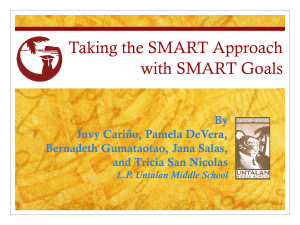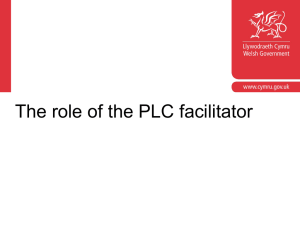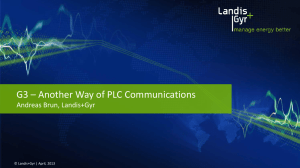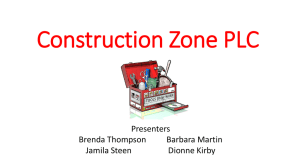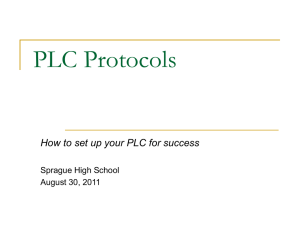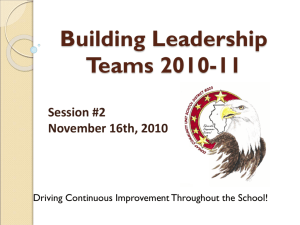PPT - Dunlap Community Unit School District #323
advertisement
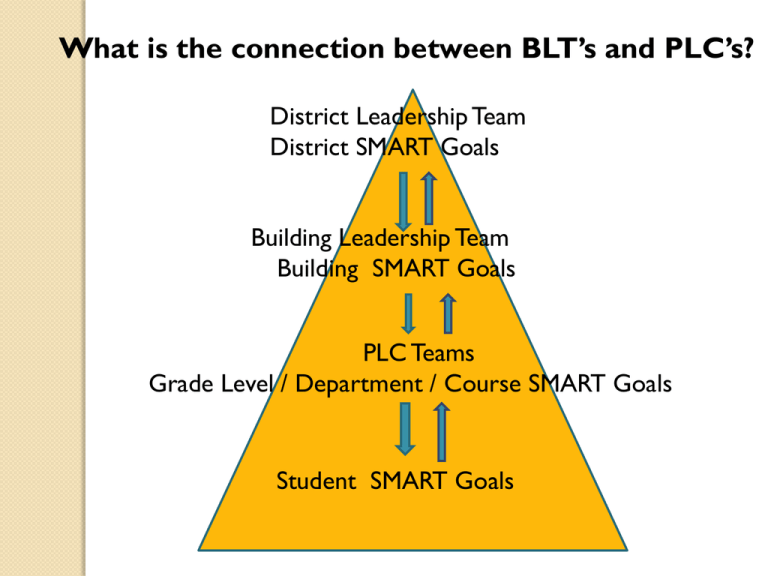
What is the connection between BLT’s and PLC’s? District Leadership Team District SMART Goals Building Leadership Team Building SMART Goals PLC Teams Grade Level / Department / Course SMART Goals Student SMART Goals Professional Learning Communities Goals for today: •Understand teams the relationship between the BLT and the PLC •Describe what PLC looks like and how it is unique from what we have experienced •Provide examples of PLC team structures •Describe •Identify characteristics of high performing PLC teams current status and future needs in regards to the critical questions What does a PLC look like? View All Things PLC video clip Listen for 5 elements Complete a T-Chart ◦ What is looks like ◦ How its unique from what we do/have done? How is it unique from what we do/have done? Look Like… Collaborative Essential knowledge Monitor learning- formative assessments Systemic Interventions Enrichment opportunities What is a PLC? Cultural Shifts View video clip and refer to your t-chart Working Collaboratively Focus on Results Learning Centered Handouts pp 28-30 LBD pp 11-14 Making Connections What are your building’s priority areas? Reflection… Where is your school? Mark on the continuum X PLC Culture Summary Summarize key findings! What are key opportunities for improvement? A Shift in Fundamental Purpose Key Strengths Key Opportunities Action/Ideas? A Shift in Use of Assessments Key Strengths Key Opportunities Action/Ideas? A Shift in the Response When Student’s Don’t Learn Key Strengths Key Opportunities Action/Ideas? A Shift in the Work of Teachers Key Strengths Key Opportunities Action/Ideas? PLC Culture Shift Summary Poster presentation: List your top 3 PLC Culture Shift areas to address at your school Identify a spokesperson to share your poster! The Collaborative Team Who is it? What will it look like? ◦ Loose/ Tight What are the responsibilities? ATP video: Collaborative Culture Collaborative Team Definition A group of people working interdependently to achieve a common goal for which members are held mutually accountable. Collaborative teams are the fundamental building blocks of PLCs. Handout p. 11 7 steps to building High-performing Teams Embedded Collaboration through teams 2. Time for teams to collaborate 3. Focus the work of teams on the “critical issues” 4. Monitor the work of teams through products 5. Establish team norms 6. Identify team SMART goals 7. Provide teams with relevant student achievement data 1. Possible Team Structures Horizontal Vertical Interdisciplinary Logical links District or regional teams Electronic teams Handout p. 12 and ATP video Team Structures Brainstorm Building teams District teams (Flip chart) Use the team definition as a guide 7 steps to building High-performing Teams Embedded Collaboration through teams 2. Time for teams to collaborate 3. Focus the work of teams on the “critical issues/questions” 4. Monitor the work of teams through products 5. Establish team norms 6. Identify team SMART goals 7. Provide teams with relevant student achievement data 1. Time for Collaboration Building the time into the schedule ◦ District Leadership Team How often will teams meet? Which teams will meet? 7 steps to building High-performing Teams Embedded Collaboration through teams 2. Time for teams to collaborate 3. Focus the work of teams on the “critical issues/questions” 4. Monitor the work of teams through products 5. Establish team norms 6. Identify team SMART goals 7. Provide teams with relevant student achievement data 1. Focus on Critical Questions What do we want our students to learn? How will we know if each student has learned it? How will we respond when some students do not learn? How can we extend and enrich the learning for students who have demonstrated proficiency? Handout p. 19 Looks Like Sounds Like What type of team structure? How are the teachers responding to each other? Which critical questions are they addressing? Team Examples 7 steps to building High-performing Teams Embedded Collaboration through teams 2. Time for teams to collaborate 3. Focus the work of teams on the “critical issues” 4. Monitor the work of teams through products 5. Establish team norms 6. Identify team SMART goals 7. Provide teams with relevant student achievement data 1. Team Products What products are the teams using? Essential Outcomes Common Assessments SMART Goals 7 steps to building High-performing Teams Embedded Collaboration through teams 2. Time for teams to collaborate 3. Focus the work of teams on the “critical issues” 4. Monitor the work of teams through products 5. Establish team norms 6. Identify team SMART goals 7. Provide teams with relevant student achievement data 1. Critical Issues for Teams Handout p. 49 Identify which critical question each statement addresses. Groups Teams Provide examples when we have formed groups and for what reason Provide examples of when we have formed teams who have addressed the critical questions Dunlap Examples Current Status Identify where your school is on the continuum Handout pp 82 & 83 Where are we as a district? (Dot activity) What do we have? What do we need? http://dunlapcusd.rubiconatlas.org Critical Question 1 What do we have in place? What do we need? Critical Question 2 What do we have in place? What do we need? Critical Question 2 What do we have in place? What do we need? Critical Question 4 Guiding Questions Complete Guiding Questions Handout pages 90 & 91 Action Plan for Staff Sharing Professional Development Action Plan Content Activities Resources Time

